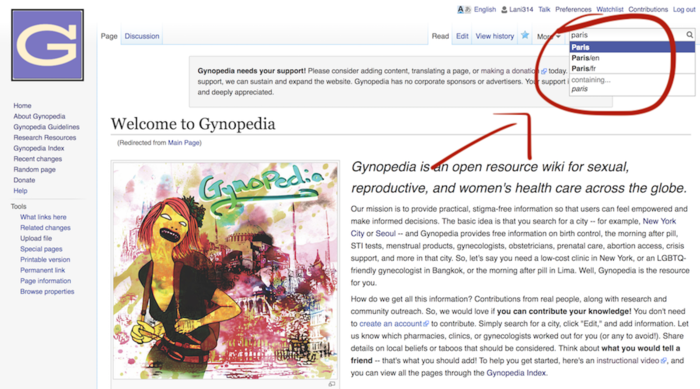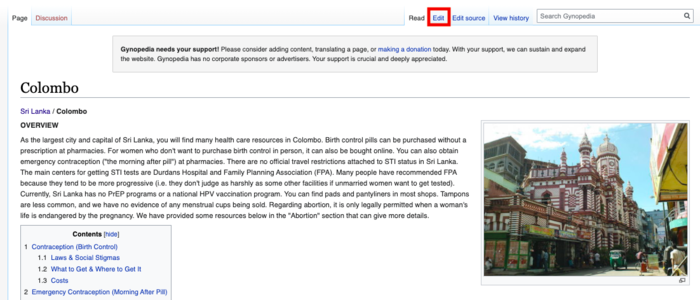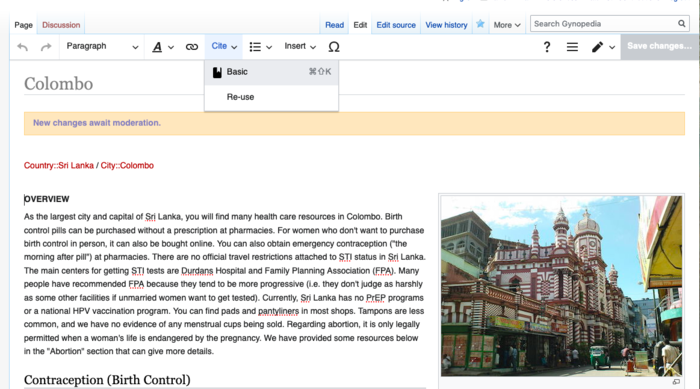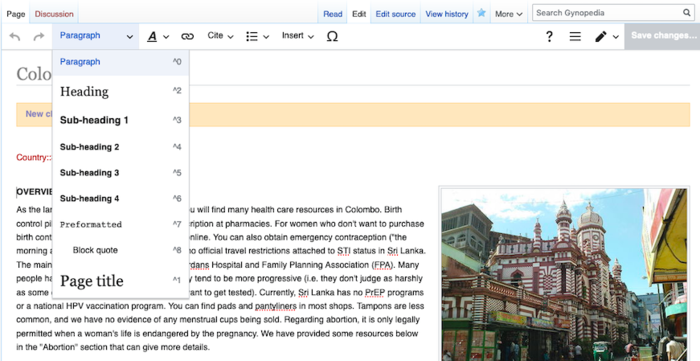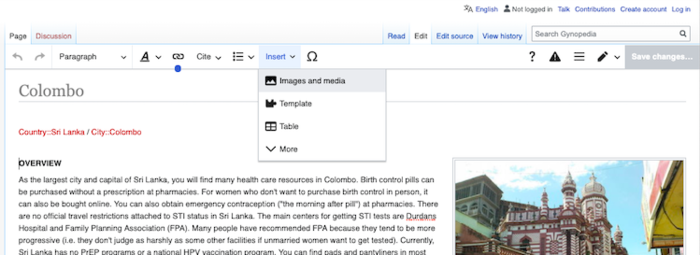Gynopedia needs your support! Please consider contributing content, translating a page, or making a donation today. With your support, we can sustain and expand the website. Gynopedia has no corporate sponsors or advertisers. Your support is crucial and deeply appreciated.
Contribute
Please join us and become an editor on Gynopedia!
Here's why:
- No prior wiki editing experience necessary! All are welcome.
- You don't need to create an account (but you can, if you want).
- You don't need to be a medical expert. You just need to have useful & reliable information.
- It's super easy to edit. Just search for a country or city, and then click "Edit."
- The information you provide can help people around the world.
- We're a grassroots labor of love! No advertisements, corporate sponsors, or sponsored content.
Watch videos before you get started
Learn through our guide
Below, you can read our guide on how to contribute information. But, if you're confused, want extra guidance, or just want to say hi, please contact us! You can email us (gynopediawiki@gmail.com), or you can find us on Facebook (@gynopedia), Twitter (@gynopedia), or Instagram (@gynopedia_global). Happy editing!
The Basics: How to Contribute Content
1. Decide if you want to create an account
You don't need to create an account to edit Gynopedia—you can begin editing immediately, if you want. But you may prefer to create an account. We'll explain both options below.
Edit after creating an account
If you want to remain anonymous, we recommend that you create a Gynopedia account. It's very fast and easy to register as a new user. You also don't need to provide an email associated with your account, but it's recommended in case you want to reset the password. Once you have registered, your edits will be anonymous, since they'll be stored under your username.
Edit without creating an account
If you want to begin editing immediately, you don't need to create an account. You can simply click "Edit" to begin editing Gynopedia pages. If you choose this option, your IP address will be stored and displayed (rather than a username). Some people care about keeping their IP address private, and some don't. It's up to you to decide what you feel comfortable with. If you don't want your IP address displayed, we recommend that you create an account.
2. Search for page to edit
After you've either created an account or decided to not create an account, you're ready to begin editing. As a first step, you should search for the city or country page you want to edit. To do this, go to the Search bar (in the top right corner of any page), and type in the name of the location (for example, "Paris"). If the page has been translated into multiple languages, you may see multiple entries for the page. To edit the original English page, select the first search result that you see (e.g. "Paris").
3. Begin editing
Once you're on a page, you can begin editing the page. Feel free to add whatever you think would be useful to people. But how do you add information? Well, it turns out that you have two choices for which editing mode to use: VisualEditor (recommended for beginners), and Source Editor (a more advanced editing tool). Keep on reading to learn more.
VisualEditor
If you're new to editing Gynopedia or other wikis, it is strongly encouraged that you use VisualEditor. It's much easier to use. Here's how you use it: Click the "Edit" button. You will then be given a visual view of the page to edit. When you're in VisualEditor, the user experience is very easy. You edit the page like how you would edit a Google Doc or Microsoft Word document. No coding or special skills are necessary! For more information, check out this VisualEditor User Guide.
Source Editor:
If you click "Edit Source," you will be in the Source Editor. When you're in this mode, you edit the page in wikitext, which is sort-of like a simplified HTML. Overall, this editing style is a bit more complex, so it's not recommended for beginners. But, if you have experience editing in wikitext or if you would like to try it out, feel free to use it! It's not very difficult, and it's easier to customize your edits in exactly the way you want.
One important note: Sometimes, pages are only available to edit in the Source Editor. This is because they have been translated. Unfortunately, the Translate extension is not compatible with VisualEditor, so you should opt for Source Editor with translated pages. Most people won't find it too difficult to use the source editor -- but, if you need help, please feel free to reach out to us!
4. Save your changes
Once you're done with the edits, click on the "Save changes" button. If you're in VisualEditor, you'll see it at the top of the page. If you're in Source Editor, you'll see it at the bottom of the page. Also, if you're in Source Editor, you can preview how your changes will look before saving, if you click "Show preview" (just remember to click "Save page" afterward).
5. Review your saved changes
After you have clicked "Save changed," your changes will be immediately saved on the page. Make sure to review your changes and confirm that they were saved correctly. For example, the formatting may look weird or maybe there's a typo. If you want to make a change, it's not big deal. Just click "Edit" to update the page. Note that your edits will be archived under your username (if you created an account) or your IP Address (if you didn't create an account).
7. You're done!
You should now be finished! Moderators of Gynopedia will review your changes and confirm that the edits are not spam or abusive content. They'll also make sure that the information is relevant and reliable to the community. If the content is valid, your edits will be officially accepted to be included onto the page for all Gynopedia readers to see.
Customize & improve your edits
1. What kind of information should I add?
If you don't know what to add, think about this way: What would you want a friend to know? What would YOU want to know? What's crucial, reliable, and real information that can help people in a time of need? This is an open and community website -- we're accepting of lots of different types of edits, including:
- Personal testimonials and experiences on receiving sexual and/or reproductive health care in a city, country, or region
- Facts on the history and social stigmas attached to sexual and/or reproductive health care in a city, country, or region
- Facts on the policies (past and present) attached to sexual and/or reproductive health care in a city, country, or region
- Facts on the general prices and payment options for sexual and/or reproductive health care in a city, country, or region
- Recommendations of clinics, health care providers, nonprofits, NGOs, hotlines, or resources in a city, country, or region
2. How does moderation work?
Unless an editor has been approved in advance, their edits will be moderated before being published. This is so we can prevent vandalism, spam, misleading, and irrelevant content to be added to Gynopedia. If we had a huge team, we could moderate content right as it became live. But, since we're a small operation, we need the Moderation extension, so we can have the flexibility to moderate new edits when we have time to look them over. We review new edits at least once per day.
So, what does this mean if you're an editor? Not much! You can still edit a page multiple times. If you make one edit and then decide to make another edit, you'll still see the version of the page you edited. Sometimes, if you leave the page and then come back, you may not see the version of the page you edited (if the edits are not yet approved by moderators). But, if you stay on the same page and make multiple edits, there shouldn't be any issues.
When your edits are approved, you won't receive a notification, but you'll be able to see them on the page. As long as the edits are done in good faith, we try to accept them. If there are small errors with them, we try to fix them ourselves. If the edits are spam, vandalism, inaccurate information, information we cannot verify, or edits that put people's security or safety at risk, we won't accept them.
If you have inquiries about the moderation status of an edit you submitted OR if you would like to become an approved editor (so no moderation is needed), you can email us (gynopediawiki@gmail.com) or reach out on social media.
3. How to add citations
If you add information that is based on personal experience, like a testimonial or first-hand account, you don't need to cite your source. Just state that is based on a personal experience, and add the date and location. For example, "Birth control pills were around 20 euros a pack (personal experience, Florence, Italy, 2015)."
However, if you are adding information based on research, you should cite your sources. Generally, if you have added any official information about history, policies, or statistics, you should cite your sources from veritable and trustworthy sources (likes newspaper publications, academic journals, and reports from the UN, WHO, nonprofits, and NGOs, etc). We have provided information below on how to do this.
Citations in VisualEditor:
Click on "Cite" in the editor toolbar. Then, to add a new citation, click "Basic." Then, copy and paste the URL of the citation. If you are using a book or a non-digital source, you can add in information on the citation. You can then reuse the same citation later in the text by clicking "Re-use."
Citations in Source Editor:
Here's the format for adding an individual citation:
Childcare in Sweden is blah blah blah.<ref>[http://www.nytimes.com/how-swedish-childcare-works New York Times: How Swedish Childcare Works]</ref>
If you will use the same source multiple times, here is how you cite the source (the first time):
Childcare in Sweden is blah blah blah.<ref name="swedish-childcare">[http://www.nytimes.com/how-swedish-childcare-works New York Times: How Swedish Childcare Works]</ref>
Once you have cited the reference the first time, here is how you cite the same reference (subsequent times):
<ref name="swedish-childcare" />
The citations will appear as a footnote in the "References" section, which can be found at the bottom fo the page. To learn more about adding citations, check out this article on Cite extension.
4. How to add links
You can add internal links (to either Gynopedia pages) or external links (to other websites).
Links in VisualEditor:
Go to the toolbar and click on the link icon (screenshot example below). You will have a choice to add a Gynopedia link or an external link.
Links in Source Editor:
For internal links, you use double brackets (see example below):
You can visit the [[Paris]] page of Gynopedia for more information.
For external links, you use single brackets (see example below)
You can visit the [[https://mediawiki.org MediaWiki]] MediaWiki website for more information.
For more details on source editor citations, you can follow this guide
5. How to add sections
Sections in VisualEditor:
To add a new section in VisualEditor, go to "Paragraph" in the toolbar. Then, you can choose whatever typing of formatting you want. If you want to type in plaintext, choose "Paragraph." If you want to have a special type of heading, you can choose from one of the heading options available.
Sections in Source Editor:
You add sections with the "=" sign. So, for example, if you want to make a header section, it looks like this:
= Header = == Subheader == === Sub-sub header ===
6. How to add images
Images in VisualEditor:
To add images, go to Insert > Images and media in the toolbar.
Images in Source Editor:
- If you are adding a new image, upload the file at the Special:Upload page.
- Add the image file into the page in the following way (see example below). In the below example, I have specified that I want the file to be a thumbnail, aligned to the right, at 400 pixels.
[[File:ImageName.jpg|400px | thumb|right|]]
How to create new pages
If you want to create a new page on Gynopedia, follow the steps below:
- Confirm that the page doesn't already exist. You can search for it in the Search bar.
- If the page doesn't already exist, you'll see text such as, "Create the page for [NAME] on this wiki!"
- Click the name that is a red link. This will redirect you to a new page, where you can begin editing.
- You can use the template we have created for new pages (just copy and paste the template content into the page). Note that the template is merely a recommendation; it's not a requirement. You can create your own page format, if you prefer.
- Template for people using Visual Editor (copy & paste this into a new page)
- Template for people using Source Editor (copy & paste this into a new page)
- Once you are done, you can publish your changes.
Additional Resources
- If you want to get a sense of some of the sources we commonly use to conduct research and develop content for Gynopedia pages, please visit the Research Resources pages.
- If you want to know more about Mediawiki (the software that Gynopedia is built on) and how it works overall, click here.
- If you want to know more about open source software, click here.
- If you wan help editing or to just say hi, reach out to us! You can email us (gynopediawiki@gmail.com), or find us on Facebook (@gynopedia), Twitter (@gynopedia), or Instagram (@gynopedia_global).

